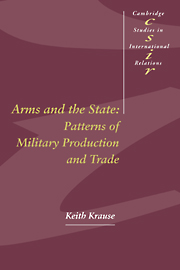Book contents
- Frontmatter
- Contents
- List of figures
- List of tables
- Acknowledgements
- Introduction
- 1 Motive forces in the evolution of the arms transfer and production system
- 2 The emergence of a global arms transfer and production system
- 3 From the Military Revolution to the Industrial Revolution
- 4 An overview of the post-1945 global arms transfer system
- 5 The dominance of first-tier producers and suppliers
- 6 Second-tier producers and suppliers: the struggle to keep pace
- 7 Dependent production and exports in the third tier
- 8 The subordinate role of arms recipients
- Conclusion
- Appendix: Arms transfer data sources and problems
- Notes
- Bibliography
- Index
5 - The dominance of first-tier producers and suppliers
Published online by Cambridge University Press: 22 September 2009
- Frontmatter
- Contents
- List of figures
- List of tables
- Acknowledgements
- Introduction
- 1 Motive forces in the evolution of the arms transfer and production system
- 2 The emergence of a global arms transfer and production system
- 3 From the Military Revolution to the Industrial Revolution
- 4 An overview of the post-1945 global arms transfer system
- 5 The dominance of first-tier producers and suppliers
- 6 Second-tier producers and suppliers: the struggle to keep pace
- 7 Dependent production and exports in the third tier
- 8 The subordinate role of arms recipients
- Conclusion
- Appendix: Arms transfer data sources and problems
- Notes
- Bibliography
- Index
Summary
Chapter 4's profile of the international arms transfer system sets the stage for a closer examination of the practices, policies and motivations of the three tiers of suppliers. Each of the following three chapters will examine the scope and evolution of arms transfers, the structure of policy and decision making and the economic dimensions of arms exports and arms production, and conclude by discussing the motive forces that govern the participation of different producers in the arms transfer and production system. Since the contemporary first-tier producers, the United States and the Soviet Union, have complex and vastly different production and decision-making structures, they will be treated separately in the following discussion.
The evolution of American arms transfers
American arms transfers have not remained relatively constant since 1945, in their volume, destination or composition. Figure 3 presents military deliveries from 1950 to 1988 (by programme), and it indicates a sharp decline in American deliveries after the Korean War and initial European rearmament, with the same high totals (in real terms) not being reached again until the early 1970s. Despite somewhat dramatic ebbs and flows since 1973, total transfers have fluctuated around an annual average of about $16,000 million. The programmes under which the transfers were made also changed radically, and different programmes each had a distinct clientele.
- Type
- Chapter
- Information
- Arms and the StatePatterns of Military Production and Trade, pp. 99 - 126Publisher: Cambridge University PressPrint publication year: 1992



